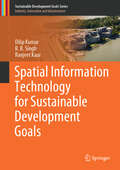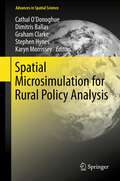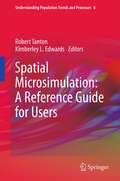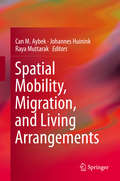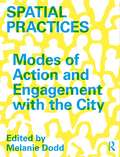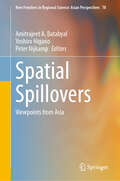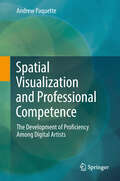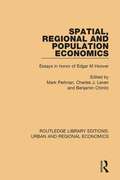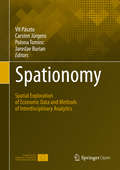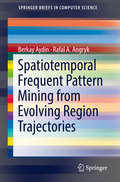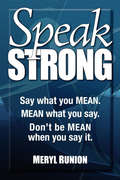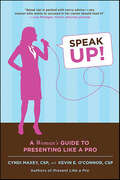- Table View
- List View
Spatial Economics for Building Back Better: The Japanese Experience (Economics, Law, and Institutions in Asia Pacific)
by Masahisa Fujita Nobuaki Hamaguchi Yoshihiro KameyamaThe central theme of this book is national land and infrastructure design in the age of the declining population and the recovery from the Great East Japan Earthquake in the affected regions in Japan. Based on the theory of spatial economics and evidence from Japanese history, the authors show that the growing economy with a population increase develops into a multi-cored and complex structure. In the population decline phase, however, such construction will be destabilized because of agglomeration economies in the central core. Then, a catastrophic shock that strikes may provoke the decline of the lower-rank-size provincial cities and their eventual disappearance if they compete only in lower prices of staple products. Not only is the practice bad for the residents; it also leads to lower national welfare resulting from the loss of diversity and overcrowded big cities. The authors argue that small local towns can recover and will be sustained if they will endeavor in innovative production by making good use of local natural resources and social capital. Under the ongoing declining population in Japan, an undesirable concentration in Tokyo will proceed further with increasing social cost and risk. The recent novel coronavirus pandemic has highlighted that concern.
Spatial Evolution of Manufacturing: Southern Ontario 1851-1891
by James M. GilmourEuropeans who settled previously unpopulated and unexploited regions of the world during the 18th and 19th centuries of the world had two economic alternatives: subsistence activities or the production of primary goods for export. In general the latter prevailed and the landscape and economy were transformed. This study examines industrial growth in Southern Ontario, one of the most economically successful regions, from 1851-1891, a period when primary activities were still very important but also when today's industrial structure was clearly being shaped. Economists, geographers, and those in related fields will welcome this approach which unites regional economic growth theory, and an empirical examination of distributional and structural change in manufacturing, in a general explanation of the spatial development of manufacturing that is relevant to all export-based regions.
Spatial Information Technology for Sustainable Development Goals (Sustainable Development Goals Series)
by Dilip Kumar R.B. Singh Ranjeet KaurThis textbook aims to develop a scientific knowledge base on spatial information technology to communicate the United Nations' Sustainable Development Goals (SDGs) among students, researchers, professionals and laymen. The book improves understanding of the spatial database and explains how to extract information from this for planning purposes. To enhance the knowledge of geoscientists and environmentalists, the book describes the basic fundamental concepts to advance techniques for spatial data management and analysis and discusses the methodology. The Geographic Information System (GIS), remote sensing and Global Positioning System (GPS) are presented in an integrated manner for the planning of resources and infrastructure. The management of these systems is discussed in a very lucid way to develop the reader's skills. The proper procedure for map making and spatial analysis are included along with case studies to the reader. Where the first part of the book discusses the conceptual background, the second part deals with case studies using these applications in different disciplines. The presented case studies include land use, agriculture, flood, watershed characterization and infrastructure assessment for the Sustainable Development Goals.
Spatial Intelligence for a Greener Planet: AI Applications in Environmental Pollution Mapping, Analysis and Mitigation
by Pradeep K. Garg Kuldeep Chaurasia P. V. Arun Yingwei YanWith rapid advancements in AI, this book reveals how AI can be a powerful tool in reducing pollution and fostering sustainability. It highlights the integration of geospatial techniques with AI for enhancing capabilities in mapping, analysis, and mitigation of environmental pollution. Starting with foundational concepts in AI, geospatial technology, and pollution, the book addresses air, water, soil and thermal pollution, emphasizing their harmful impacts. Through real-world case studies and advanced research, it showcases AI and geospatial technology's revolutionary role in pollution mitigation, exploring AI-driven sensors, satellite imagery, and associated networks for precise and efficient pollution monitoring and management.
Spatial Interaction Models with Land Use: A Tool for Interdisciplinary Analysis and Integrated Territorial Policy (Contributions to Regional Science)
by Tomaz Ponce Dentinho Paulo SilveiraThis book develops spatial interaction models for the analysis of human interaction within space, in terms of both accessibility and land use. Presenting case studies on the Azores and Morocco, it covers applications in various regions of Europe and Africa. The respective models simulate land use, employment, households, commuting and shopping movements and land values, employment distribution for basic activities, changes in accessibility, and changes in land suitability due to climate change.This book will appeal to scholars and students of regional and spatial science, ecological economics, and agricultural economics, as well as to spatial planners and practitioners dealing with issues of spatial planning to address such problems as unsustainable land use, adaptation to climate change, desertification of rural areas heavily dependent on land use, and the impacts of external shocks on land and property values.
Spatial Justice and Cohesion: The Role of Place-Based Action in Community Development (ISSN)
by James W. Scott Matti Fritsch Petri Kahila Sarolta NémethPlace-based strategies are widely discussed as powerful instruments of economic and community development. In terms of the European debate, the local level – cities, towns and neighbourhoods – has recently come under increased scrutiny as a potentially decisive actor in Cohesion Policy. As understandings of socio-spatial and economic cohesion evolve, the idea that spatial justice requires a concerted policy response has gained currency.Given the political, social and economic salience of locale, this book explores the potential contribution of place-based initiative to more balanced and equitable socio-economic development, as well as growth in a more general sense. The overall architecture of the book and the individual chapters address place-based perspectives from a number of vantage points, including the potential of achieving greater effectiveness in EU and national level development policies, through a greater local level and citizens' role and concrete actions for achieving this; enhancing decision-making autonomy by pooling local capacities for action; linking relative local autonomy to development outcomes and viewing spatial justice as a concept and policy goal. The book highlights, through the use of case studies, how practicable and actionable knowledge can be gained from local development experiences.This book targets researchers, practitioners and students who seek to learn more about place-based based development and its potentials. Its cross-cutting focus on spatial justice and place will ensure that the book is of wider international interest.The Open Access version of this book, available at www.taylorfrancis.com, has been made available under a Creative Commons Attribution-Non Commercial-No Derivatives (CC-BY-NC-ND) 4.0 license. Funded by The University of Eastern Finland.
Spatial Justice and Cohesion: The Role of Place-Based Action in Community Development (Regions and Cities)
by James W. Scott Matti Fritsch Petri Kahila Sarolta NémethPlace-based strategies are widely discussed as powerful instruments of economic and community development. In terms of the European debate, the local level – cities, towns and neighbourhoods – has recently come under increased scrutiny as a potentially decisive actor in Cohesion Policy. As understandings of socio-spatial and economic cohesion evolve, the idea that spatial justice requires a concerted policy response has gained currency. Given the political, social and economic salience of locale, this book explores the potential contribution of place-based initiative to more balanced and equitable socio-economic development, as well as growth in a more general sense. The overall architecture of the book and the individual chapters address place-based perspectives from a number of vantage points, including the potential of achieving greater effectiveness in EU and national level development policies, through a greater local level and citizens' role and concrete actions for achieving this; enhancing decision-making autonomy by pooling local capacities for action; linking relative local autonomy to development outcomes and viewing spatial justice as a concept and policy goal. The book highlights, through the use of case studies, how practicable and actionable knowledge can be gained from local development experiences. This book targets researchers, practitioners and students who seek to learn more about place-based based development and its potentials. Its cross-cutting focus on spatial justice and place will ensure that the book is of wider international interest.
Spatial Microeconometrics (Routledge Advanced Texts in Economics and Finance)
by Giuseppe Arbia Giuseppe Espa Diego GiulianiSpatial Microeconometrics introduces the reader to the basic concepts of spatial statistics, spatial econometrics and the spatial behavior of economic agents at the microeconomic level. Incorporating useful examples and presenting real data and datasets on real firms, the book takes the reader through the key topics in a systematic way. The book outlines the specificities of data that represent a set of interacting individuals with respect to traditional econometrics that treat their locational choices as exogenous and their economic behavior as independent. In particular, the authors address the consequences of neglecting such important sources of information on statistical inference and how to improve the model predictive performances. The book presents the theory, clarifies the concepts and instructs the readers on how to perform their own analyses, describing in detail the codes which are necessary when using the statistical language R. The book is written by leading figures in the field and is completely up to date with the very latest research. It will be invaluable for graduate students and researchers in economic geography, regional science, spatial econometrics, spatial statistics and urban economics.
Spatial Microsimulation for Rural Policy Analysis
by Cathal O'Donoghue Stephen Hynes Karyn Morrissey Graham Clarke Dimitris BallasThe aim of this book is to explore the challenges facing rural communities and economies and to demonstrate the potential of spatial microsimulation for policy and analysis in a rural context. This is done by providing a comprehensive overview of a particular spatial microsimulation model called SMILE (Simulation Model of the Irish Local Economy). The model has been developed over a ten year period for applied policy analyis in Ireland which is seen as an ideal study area given its large percentage of population living in rural areas. The book reviews the policy context and the state of the art in spatial microsimulation against which SMILE was developed, describes in detail its model design and calibration, and presents example of outputs showing what new information the model provides using a spatial matching process. The second part of the book explores a series of rural issues or problems, including the impacts of new or changing government or EU policies, and examines the contribution that spatial microsimulation can provide in each area.
Spatial Microsimulation: A Reference Guide for Users
by Kimberley Edwards Robert TantonThis book is a practical guide on how to design, create and validate a spatial microsimulation model. These models are becoming more popular as academics and policy makers recognise the value of place in research and policy making. Recent spatial microsimulation models have been used to analyse health and social disadvantage for small areas; and to look at the effect of policy change for small areas. This provides a powerful analysis tool for researchers and policy makers. This book covers preparing the data for spatial microsimulation; a number of methods for both static and dynamic spatial microsimulation models; validation of the models to ensure the outputs are reasonable; and the future of spatial microsimulation. The book will be an essential handbook for any researcher or policy maker looking to design and create a spatial microsimulation model. This book will also be useful to those policy makers who are commissioning a spatial microsimulation model, or looking to commission work using a spatial microsimulation model, as it provides information on the different methods in a non-technical way.
Spatial Mobility of Migrant Workers in Beijing, China
by Ran LiuThe great migration of farmers leaving rural China to work and live in big cities as 'floaters' has been an on-going debate in China for the past three decades. This book probes into the spatial mobility of migrant workers in Beijing, and questions the city 'rights' issues beneath the city-making movement in contemporary China. In revealing and explaining the socio-spatial injustice, this volume re-theorizes the 'right to the city' in the Chinese context since Deng Xiaoping's reforms. The policy review, census analysis, and housing survey are conducted to examine the fate of migrant workers, who being the most marginalized group have to move persistently as the city expands and modernizes itself. The study also compares the migrant workers with local Pekinese dislocated by inner city renewals and city expansion activities. Rapid urban growth and land expropriation of peripheral farmlands have also created a by-product of urbanization, an informal property development by local farmers in response to rising low-cost rental housing demand. This is a highly comparable phenomenon with cities in other newly industrialized countries, such as São Paulo. Readers will be provided with a good basis in understanding the interplay as well as conflicts between migrant workers' housing rights and China's globalizing and branding pursuits of its capital city. Audience: This book will be of great interest to researchers and policy makers in housing planning, governance towards urban informalities, rights to the city, migrant control and management, and housing-related conflict resolutions in China today.
Spatial Mobility, Migration, and Living Arrangements
by Can M. Aybek Johannes Huinink Raya MuttarakThis book brings together ten original empirical works focusing on the influence of various types of spatial mobility - be it international or national- on partnership, family and work life. The contributions cover a range of important topics which focus on understanding how spatial mobility is related to familial relationships and life course transitions. The volume offers new insights by bringing together the state of the art in theoretical and empirical approaches from spatial mobility and international migration research. This includes, for example, studies that investigate the relationships between international migration and changing patterns of partnership choice, family formation and fertility. Complementing to this, this volume presents new empirical studies on job-related residential mobility and its impact on the relationship quality of couples, family life, and union dissolution. It also highlights the importance of research that looks at the reciprocal relationships between mobility and life course events such as young adults leaving the parental home in international migration context, re-arrangements of family life after divorce and spatial mobility of the elderly following life transitions. The scholarly work included in this volume does not only contribute to theoretical debates but also provide timely empirical evidence from various societies which represent the common features in the dynamics of spatial mobility and migration.
Spatial Planning and the European Union: Europeanisation from Within (Routledge Advances in Regional Economics, Science and Policy)
by Eva PurkarthoferEuropean Union policies are intertwined with all sectors of public administration and governance in the member states, including spatial, urban and regional planning. Legal regulations like the Natura 2000 Directives, funding programmes associated with EU Cohesion Policy or strategies such as the Territorial Agenda 2030 all leave their mark on planning – yet with considerably different effects in Europe’s cities and regions.This book serves as a guide to navigate the connection points between EU policies and spatial planning by introducing the logics of EU policymaking and European spatial planning, outlining the most important EU policies with relevance for spatial planning and presenting examples, from Austria and Finland, of how EU policies are applied in domestic contexts. By exploring the Europeanisation of spatial planning ‘from within’, the book acknowledges how differential ideas about what spatial planning is and what role the EU plays therein shape the actualised impacts of EU policies.By providing a comprehensive perspective on the relevance of the European Union for spatial planning, this book is ideal for students, academics and administrators who want to grasp how the EU shapes and affects planning practice in Europe’s cities and regions.
Spatial Planning in Poland: Law, Property Market and Planning Practice (SpringerBriefs in Geography)
by Maciej J. Nowak Przemysław Śleszyński Paulina Legutko-KobusThis book defines the dilemmas related to the interface between legal regulations and planning practice in the spatial management system. Based on specific case studies, it gives examples of possible problems and ways of solving them. It applies to Poland's standard and the determinants of spatial policy in other countries. It provides the basis for a developed international discussion and concretely suggests specific actions at local, regional and national levels.
Spatial Practices: Modes of Action and Engagement with the City
by Melanie DoddThis book explores ‘spatial practices’, a loose and expandable set of approaches that embrace the political and the activist, the performative and the curatorial, the architectural and the urban. Acting upon and engaging with the public realm, the field of spatial practices allows people to reconnect with their own sense of agency through engagement in space and place, exploring and prototyping alternative futures in the here and now. The 24 chapters contain essays, visual essays and interviews, featuring contributions from an international set of experimental practitioners including Jeanne van Heeswijk (Netherlands), Teddy Cruz (Estudio Teddy Cruz + Fonna Forman, San Diego), Hector (USA), The Decorators (London) and OOZE (Netherlands). Beautifully designed with full colour illustrations, Spatial Practices advances dialogue and collaboration between academics and practitioners and is essential reading for students, researchers and professionals in architecture, urban planning and urban policy.
Spatial Spillovers: Viewpoints from Asia (New Frontiers in Regional Science: Asian Perspectives #78)
by Peter Nijkamp Amitrajeet A. Batabyal Yoshiro HiganoThis edited book is the first to bring together in one place new theoretical and empirical evidence as well as case studies about spatial spillovers, with a particular focus on spillovers in Asia. In the context of this book, spatial spillovers are locally bounded and territorially rooted interactions between one or more economic agents and their environments. They are salient because they affect regional economic growth and development. Specifically, the individual chapters in this book shed light on the different kinds of spatial spillovers witnessed in Asian regions, particularly those that derive from the acquisition and transfer of knowledge, those that arise from horizontal or vertical industrial interactions, and those that come about because of economic growth. The book departs from the existing literature in three ways. First, the book explicitly recognizes that different kinds of spatial spillovers have dissimilar impacts on the lives and therefore on the welfare of the residents of different regions. Second, the book emphasizes the varied dimensions of the interactions and the ways in which these dimensions influence different societies. Third, this book demonstrates the ways in which an understanding of the preceding two points contributes to our knowledge about the nexuses between spatial spillovers and regional economic growth and development. Because Asia is the fastest growing and the most dynamic continent in the world today, the research delineated in the individual chapters of the book provides practical guidance concerning two salient questions. First, how do we effectively address the economic growth and development challenges stemming from spatial spillovers between one or more regions within Asia? Second, how do we ensure that the policies we design to address these challenges give rise to broad-based and sustainable economic growth and development?
Spatial Visualization and Professional Competence: The Development Of Proficiency Among Digital Artists
by Andrew PaquetteThe computer graphics (CG) industry is an attractive field for undergraduate students, but employers often find that graduates of CG art programmes are not proficient. The result is that many positions are left vacant, despite large numbers of job applicants. This book investigates how student CG artists develop proficiency. The subject is important to the rapidly growing number of educators in this sector, employers of graduates, and students who intend to develop proficiency for the purpose of obtaining employment. Educators will see why teaching software-oriented knowledge to students does not lead to proficiency, but that the development of problem-solving and visualisation skills do. This book follows a narrow focus, as students develop proficiency in a cognitively challenging task known as ‘NURBS modelling’. This task was chosen due to an observed relationship between students who succeeded in the task, and students who successfully obtained employment after graduation. In the study this is based on, readers will be shown that knowledge-based explanations for the development of proficiency do not adequately account for proficiency or expertise in this field, where visualisation has been observed to develop suddenly rather than over an extended period of time. This is an unusual but not unique observation. Other studies have shown rapid development of proficiency and expertise in certain professions, such as among telegraph operators, composers and chess players. Based on these observations, the book argues that threshold concepts play a key role in the development of expertise among CG artists.
Spatial, Regional and Population Economics: Essays in honor of Edgar M Hoover (Routledge Library Editions: Urban and Regional Economics)
by Mark Perlman Charles J. Leven Benjamin ChinitzOriginally published in 1972. Hoover’s first publication, his doctoral dissertation, set the stage for a life-long preoccupation with spatial economics from when it was a relatively new field. His work developed the subject and lead him into the area of regional economics, in which he became well known for his contributions to the New York Metropolitan Region Study. In this book his colleagues and a host of former students and admirers present chapters written within his areas of interest in honor of his work, at the end of his academic career, during which he mostly taught at the University of Michigan and the University of Pittsburgh.
Spatial-Economic Metamorphosis of a Nebula City: Schiphol and the Schiphol Region During the 20th Century (Routledge Studies in Human Geography #163)
by Abderrahman El MakhloufiThis book analyses the long term spatial-economic metamorphosis of Schiphol and the Schiphol region as archetypal for a wider international phenomenon of urban development of metropolises across the world. It study the origins and course of urban development process by identifying and explaining which (collective) arrangements, including their ambient factors and the visual representations of the city and urbanity, have influenced this metamorphosis in a decisive manner.
Spationomy: Spatial Exploration of Economic Data and Methods of Interdisciplinary Analytics
by Carsten Jürgens Vít Pászto Polona Tominc Jaroslav BurianThis open access book is based on "Spationomy – Spatial Exploration of Economic Data", an interdisciplinary and international project in the frame of ERASMUS+ funded by the European Union. The project aims to exchange interdisciplinary knowledge in the fields of economics and geomatics. For the newly introduced courses, interdisciplinary learning materials have been developed by a team of lecturers from four different universities in three countries. In a first study block, students were taught methods from the two main research fields. Afterwards, the knowledge gained had to be applied in a project. For this international project, teams were formed, consisting of one student from each university participating in the project. The achieved results were presented in a summer school a few months later. At this event, more methodological knowledge was imparted to prepare students for a final simulation game about spatial and economic decision making. In a broader sense, the chapters will present the methodological background of the project, give case studies and show how visualisation and the simulation game works.
Spatiotemporal Frequent Pattern Mining from Evolving Region Trajectories (SpringerBriefs in Computer Science)
by Berkay Aydin Rafal. A AngrykThis SpringerBrief provides an overview within data mining of spatiotemporal frequent pattern mining from evolving regions to the perspective of relationship modeling among the spatiotemporal objects, frequent pattern mining algorithms, and data access methodologies for mining algorithms. While the focus of this book is to provide readers insight into the mining algorithms from evolving regions, the authors also discuss data management for spatiotemporal trajectories, which has become increasingly important with the increasing volume of trajectories.This brief describes state-of-the-art knowledge discovery techniques to computer science graduate students who are interested in spatiotemporal data mining, as well as researchers/professionals, who deal with advanced spatiotemporal data analysis in their fields. These fields include GIS-experts, meteorologists, epidemiologists, neurologists, and solar physicists.
Spatiotemporal Transportation Economics Development: Theories and Practices in China and Beyond
by Hongchang LiThis book focuses on the analysis of transportation economics development with spatiotemporal characteristics in both theory and practice. The comprehensive and general theory development, practical transportation events and policy implications are addressed. The book pursues three main objectives: firstly, to structurally describe the overall spatiotemporal transportation theory development; secondly, to break down transportation elements and transportation modes into railway, highway, water, civil aviation, pipeline and urban transportation for the purposes of in-depth professional analysis; and thirdly, to summarize transportation trends including car-hailing, shared bicycles, etc., in China to reveal their policy implications.
Speak Strong: Say What You Mean! Mean What You Say. Don't Be Mean When You Say It
by Meryl Runion“Speak Strong!” It’s a leadership skill, a success strategy and a moral imperative. Research shows 90% of us stay silent in situations that call for strong words. Don’t want to rock the boat? Author Meryl Runion, CSP, explains why some boats NEED to be rocked…for the right reasons…at the right time…in the right way. Know when it’s time to speak up, overcome resistance to unwelcome truths, establish and implement boundaries, create new communication standards, supercharge your message, elevate the quality of your conversations, overcome destructive communication habits, put your best foot forward sincerely. One hour audio CD included containing the entire searchable PDF of the bestselling PowerPhrases! book so you can immediately get the words to apply your SpeakStrong skills. The CD also includes a communication style inventory, the flash presentation of "The Legend of Mighty Mouth and of A World of Truth" and more. Meryl Runion’s "PowerPhrases!" book Series has helped over a quarter million readers find the perfect phrases to communicate clearly. “Speak Strong” is the perfect “next step” for those who rely on communication skills to build successful careers and relationships.
Speak Up!: A Woman's Guide to Presenting Like a Pro
by Cyndi Maxey Kevin E. O'ConnorThe insider's guide for women who want to master the art of business, professional, and public speakingWhether speaking one-on-one or one to one thousand, women have specific challenges that can get in the way of their ability to convey ideas and engage an audience. Public speaking professionals Cyndi Maxey and Kevin O'Connor give women the tips and tools they need to be able to speak clearly, with confidence and conviction, and present information effectively.In SPEAK UP!, you'll learn how to:Deal with difficult colleaguesSpeak on the spotUse technology in support of your messageSell your ideas with passion and power Connect confidently with your superiorsFor any woman who wants to get her point across, from the boss' office, to the conference room, to a convention center, SPEAK UP! will help you polish your presentation skills, get heard, and get what you want.
Speak Without Fear: A Total System for Becoming a Natural, Confident Communicator
by Ivy NaistadtFor many of us, public speaking is at best a chore marked by great anxiety and at worst a potential career stopper. Ours is a time when the ability to communicate in front of individuals or groups in all types of business and other situations is becoming paramount. Speak Without Fear offers a unique, practical process for combating the stage fright that plagues us every day in these situations. Unlike other books on public speaking, Speak Without Fear goes beyond the external techniques, such as how to breathe properly and keep eye contact, to delve deeply into the reason for your performance anxiety. It gets to the root of what's giving you the sweats so you can identify what's in the way and work through it to communicate naturally and comfortably before audiences of any size. Ivy Naistadt's easy-to-follow, step-by-step program will help you: Identify the degree and type of your nervousness Pinpoint the incidents and issues that, directly or indirectly, cause you fear and loathing in the spotlightDevelop and master a technique for over-coming your anxiety that's adaptable to your level of experience and needUse your new skills to shine in a variety of situations -- whether speech making, interviewing, auditioning, or presenting No matter how anxious you are about going before an audience -- any audience, whether it's 1 or 1,000 -- Speak Without Fear will give you the tools to speak powerfully and persuasively.


